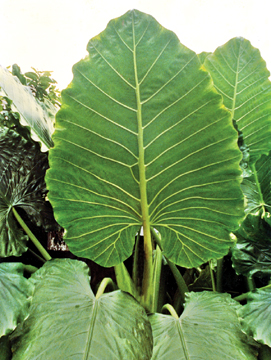Aroid

Aroid (kachu) monocotyledonous herbaceous plants of the family Araceae, one of the oldest domesticated group of plants that grow in moist and shady places; originated in the tropics of Old World. The edible part is the enlarged root that acts as a storage organ. Most aroids are terrestrial, some are vines, creepers or climbers; many are also epiphytes. Many are cultivated and used as food, some are used as ornamentals, while a few have medicinal value. The average yield is about 8 m tons/ha. The major edible ariods are classified under five genera: Cyrtosperma, Amorphophallus, Colocasia, A1ocasia, and Xanthosoma. Among the aroids in Bangladesh, Mukhi Kachu and Pani Kachu are most important and are commercially grown in all parts of the country. Dudh Kachu and Moulavi Kachu are mainly cultivated in some areas for their stem and foliage; leaves of wild Colocasia plants are also consumed.
One variety of Mukhi Kachu, called Bilasi yields 30-35 m tons per ha. The corms of Mukhi Kachu are rich in starch and can be eaten in a way similar to potatoes. One improved variety of Pani Kachu called Latiraj is primarily cultivated for stolons, its rhizomes which are not of good quality may be considered as a by-product. Latiraj can give 25-30 m tons of stolons and 15-20 m tons of rhizomes per ha. The stolons are 90-100 cm long, of medium thickness, soft when boiled, and least acrid.
The corms of good quality arum, are rich in starch, and like potatoes, can be boiled, baked, roasted or fried in oils. From the flesh, a flour similar to that of potato can be produced for soups, biscuits, bread, beverages, and pudding. Easily digested, this starch can be used in baby foods. Although low in protein and fat content, it is a good source of minerals, such as calcium and phosphorus, and vitamin A and B. [Gour Pada Das and Nishit Kumar Paul]
See also tuber crop.
